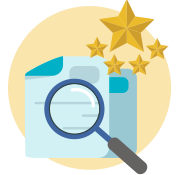
Welcome to the second module of our journey in the course "SmartBusiness, Digital Marketing for Scientific Illustrator." As we delve into the art of defining your target audience, it's crucial to remember your PROFESSIONAL ASPIRATIONS laid out in your Roadmap to Success and translate them into ONLINE MARKETING STRATEGIES in your Guide to Success.
Just as a compass guides a traveler, the roadmap we've established serves as your guiding light in navigating the vast landscape of digital marketing.

Your aspirations and dreams as a scientific illustrator are the North Star, and the answers in your guide will ensure that your efforts are focused, strategic, and aligned with your ultimate goals.
Remember, at the heart of this journey lies your unique perspective and creative prowess as a scientific illustrator. By identifying and understanding your target audience, you are equipping yourself with a powerful tool that will enable you to communicate effectively, connect authentically, and ultimately flourish in your chosen career path.
Now, let's explore how you can define your target audience and tailor your digital marketing efforts to meet their specific requirements:
Step 1: Identify Your Scientific Niche
Start by pinpointing the specific scientific niche or field that you specialize in or are passionate about. It could be biology, astronomy, chemistry, or any other area. Understanding your niche will help you focus your digital marketing efforts and tailor your content to a specific audience.
Step 2: Determine Your Target Audience
Consider who would benefit most from your scientific illustrations. Are they students, researchers, educators, or a combination? Think about their age, educational background, level of expertise, and specific interests within the scientific realm. This will help you create content that speaks directly to their needs.

Step 3: Research Digital Habits
Explore where your target audience spends their time online. Do they engage with social media platforms? Are they active on educational websites, science forums, or blogs? Knowing their digital habits will allow you to strategically place your content where they are most likely to discover it.
Step 4: Understand Content Preferences
Delve into the type of content that resonates with your target audience. Do they prefer concise visuals, in-depth articles, or video tutorials? Are infographics, animations, or interactive elements more engaging to them? Knowing their content preferences will guide your creative decisions and ensure your digital marketing materials appeal to them.
Step 5: Engage and Gather Feedback
Encourage direct interaction with your target audience through your website, social media accounts, or email newsletters. Ask questions, invite discussions, and actively listen to their responses. Their feedback will provide valuable insights into their pain points, interests, and expectations, helping you refine your digital marketing strategies.
Step 6: Collaborate with Influencers, Experts or Related Service Providers
Consider collaborating with influencers or experts in your scientific field who have a strong online presence. Partnering with them can help you tap into their existing audience and establish credibility. Collaborative content or sharing their expertise can enhance your visibility among your target audience and build trust in your work as a scientific illustrator.
On the other hand, in the field of scientific illustration, it often happens that our target market doesn't directly seek out illustrators to meet their needs. Sometimes, they may not even be familiar with the term or name of our profession as we know it.
Absurd, isn't it? But it's true.
Our target market often looks for related service providers to fulfill their scientific illustration needs. For example, marketing agencies, advertising agencies, or graphic design services.
So, here's what I advise:
During your conversations with potential clients, ask them how scientific illustrators are known among their colleagues and how they have found and hired them in the past.
Offer your services to alternative or related service providers in our profession.
Use the Google tool called Keyword Planner to discover the related terms people use when searching for scientific illustration services.
By following these recommendations, you can expand your reach and increase your chances of being discovered by potential clients who may not be familiar with the specific term "scientific illustrator" or “medical illustrator”. It's all about understanding the alternative channels and language that your target market uses to find and engage with the services you offer.
Keep exploring and adapting your approach to effectively connect with your audience. By being proactive and open to different avenues, you can tap into new opportunities and broaden your client base in the field of scientific illustration.
Step 7: Stay Informed and Evolve
Keep yourself updated on the latest trends and advancements in the scientific community. Stay connected with reputable scientific publications, attend conferences, and engage in online communities. By staying informed, you can anticipate the evolving interests and needs of your target audience, keeping your digital marketing efforts fresh and relevant.

Conclusion
Remember, these steps are not static. Continuously reassess your target audience and their needs as you learn and grow. Digital marketing as a scientific illustrator is an ongoing process of understanding and adapting to effectively reach and engage with your audience. So, embrace the journey, stay curious, and let your digital marketing efforts bring the wonders of science to a wider audience!
Researching Potential Clients
In the realm of scientific illustration, a crucial aspect of building a successful career lies in understanding and effectively reaching your target audience. This section will guide you through the process of identifying and connecting with potential clients:

Scientific Institutions:
Begin your research by identifying scientific institutions such as research organizations, universities, and laboratories. Investigate their ongoing projects, publications, and areas of expertise. This will provide insights into the kind of illustrations they might require and the visual styles they prefer.
Educational Publishers:
Explore educational publishers specializing in scientific content. Understand the types of materials they publish, whether it's textbooks, educational modules, or online resources. Familiarize yourself with the target audience for these materials and the visual elements that resonate with them.
Medical Companies:
Investigate pharmaceutical companies, medical device manufacturers, and healthcare organizations. Learn about the products or services they offer, and understand the visual requirements for marketing, educational, and research purposes in the medical field.
Environmental Agencies:
For those interested in environmental illustration, research governmental and non-governmental environmental agencies. Identify their focus areas, ongoing projects, and the specific visual elements they use to communicate complex scientific concepts to the public.
Museums:
Museums play a pivotal role in preserving and presenting scientific knowledge to the public. As potential clients, museums seek captivating visuals to enhance exhibits, educational materials, and outreach programs.
Scientific illustrators can contribute significantly by providing accurate and visually engaging representations, aiding museums in making complex scientific concepts accessible to diverse audiences. Collaborating with museums not only provides opportunities for showcasing your skills but also contributes to the broader mission of promoting scientific literacy and appreciation.

Understanding Specific Needs and Visual Styles
Scientific Institutions:
Engage with the scientific community through conferences, publications, and online platforms to understand their language, priorities, and visual preferences. Scientific accuracy and clarity are paramount in this domain.
Educational Publishers:
Analyze the design styles and layouts commonly used in educational materials. Consider factors such as age groups, educational levels, and the level of detail required in illustrations.

Medical Companies:
Familiarize yourself with medical terminology, anatomical structures, and the visual standards in the healthcare industry. Ensure that your illustrations align with the precision required in medical communication.
Environmental Agencies:
Gain insights into environmental issues, conservation efforts, and scientific communication within the environmental sector. Understand how visual storytelling can effectively convey complex ecological concepts.
Museums
Museums, as clients, have distinct requirements for scientific illustrators. They seek illustrations that seamlessly integrate into exhibits, enhance educational materials, and contribute to outreach programs.
The visuals must be engaging, adaptable to various display formats, and possess a narrative quality for storytelling purposes. Accuracy is paramount, ensuring authenticity in historical or scientific depictions.
Scientific illustrators working with museums should blend precision with creativity, creating visuals that captivate audiences while aligning with the museum's educational and narrative objectives.
Targeting Projects Aligned with Your Skills
and Interests
Assess Your Skills:
Identify your strengths and areas of expertise within scientific illustration. Consider the types of projects that align with your proficiency, whether it's microscopic illustrations, anatomical drawings, or environmental scenes.
Define Your Interests:
Determine your passion within the scientific field – whether it's biology, astronomy, medicine, or environmental science. Focusing on projects aligned with your interests not only enhances your job satisfaction but also ensures a genuine connection with your work.
Create a Niche:
Establishing a niche within scientific illustration allows you to stand out in a competitive market. Specializing in a particular subject matter or style can make you the go-to illustrator for specific types of projects.
Conclusion
In conclusion, the key to success in the world of scientific illustration lies in meticulous research and alignment with the needs and visual preferences of your target audience. By honing your skills, understanding the intricacies of different sectors, and focusing on projects that resonate with your interests, you'll be well-positioned to thrive in the digital marketing landscape for scientific illustrators.

